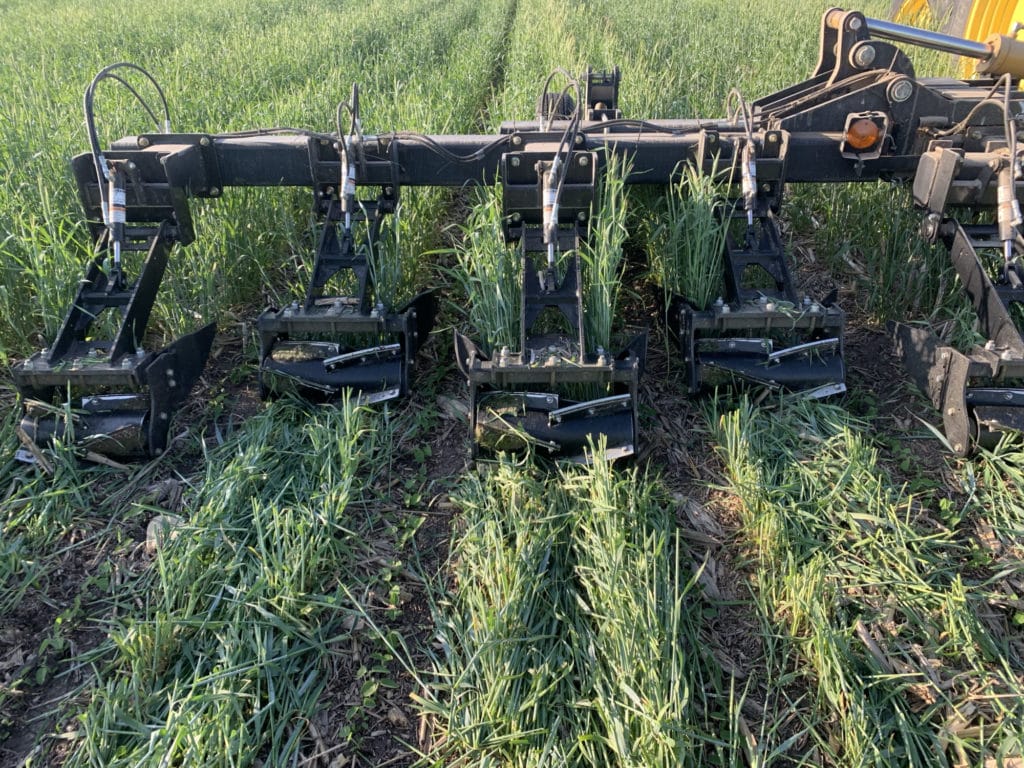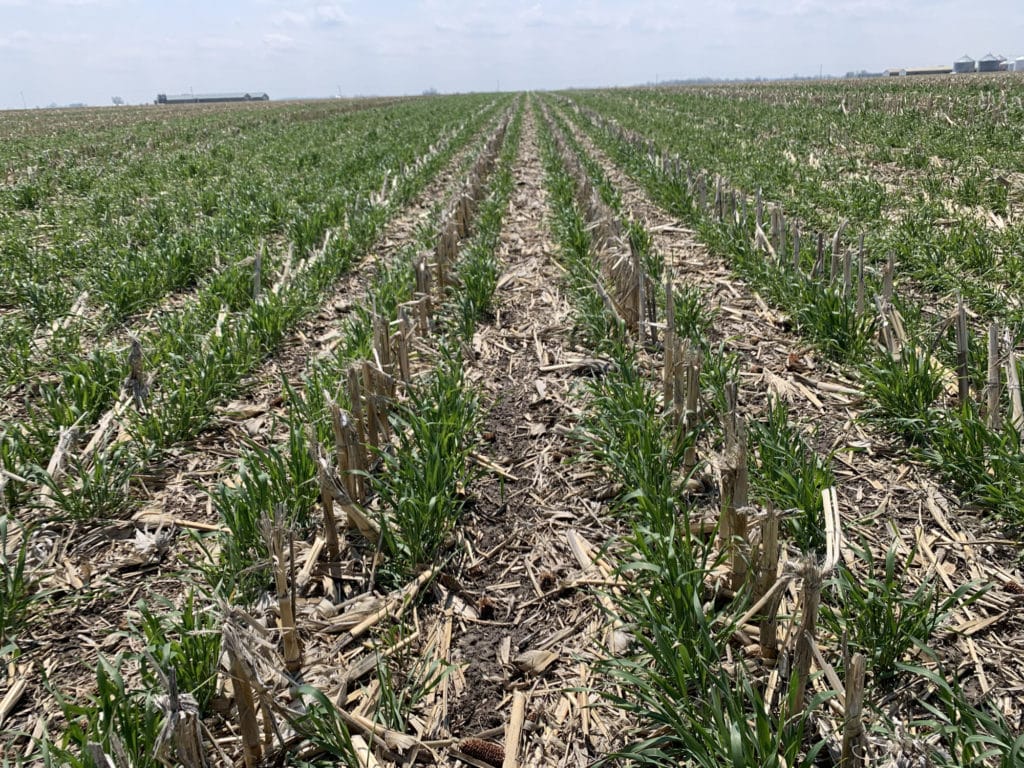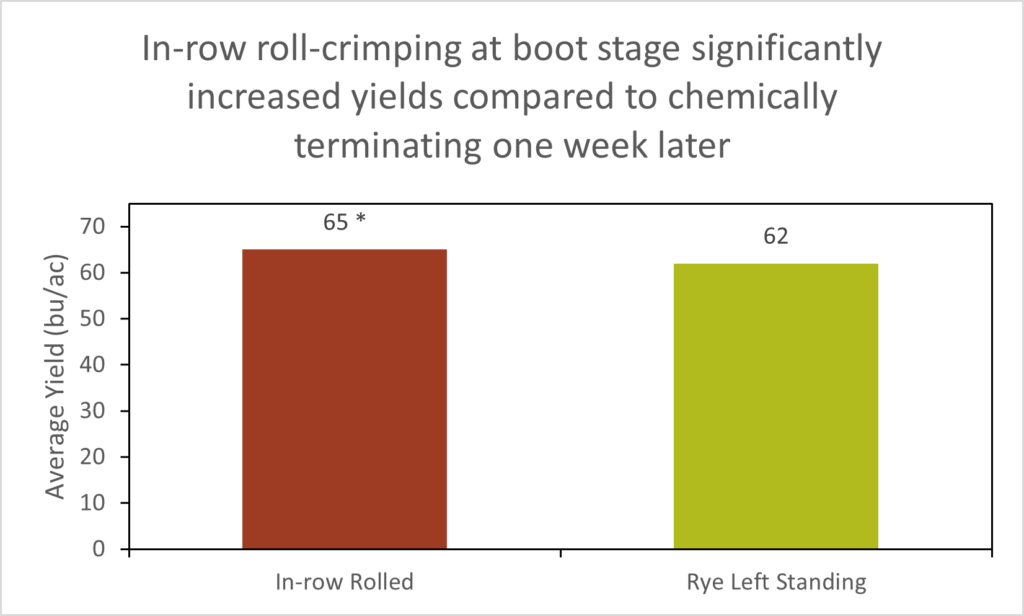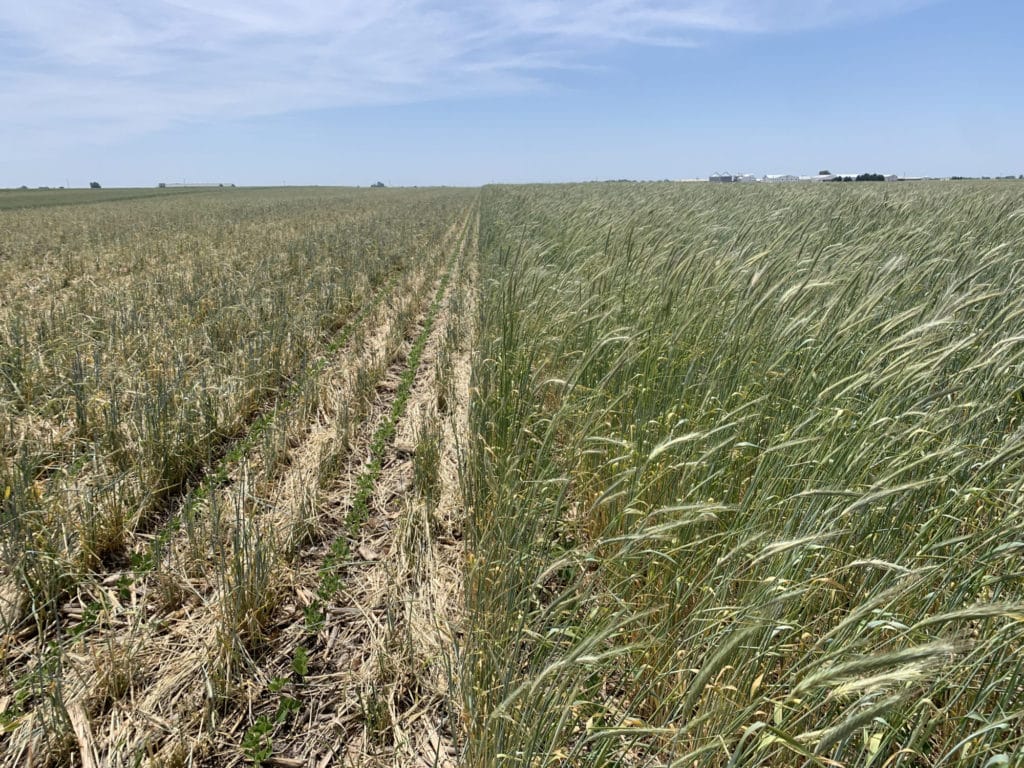In-Row Roll-Crimping Cereal Rye Cover Crop Seeded in Twin-Rows Ahead of Soybeans
This research report was funded by USDA-NRCS and Cargill.
In a Nutshell:
- An in-row roller crimper is designed to roll-crimp only in the interrow between cash crop rows. Michael Vittetoe seeds cover crop in 10-in. twin-rows on 30-in. centers so that he can plant soybeans between cover crop rows and roll-crimp later with an in-row roller crimper.
- Vittetoe assessed how in-row roll-crimping of a cereal rye cover crop at boot stage affected soybean yield compared to chemically terminating the cover crop just after boot stage and leaving it standing.
Key Findings
- Soybean yield when rye was roll-crimped at boot stage was 65 bu/ac, significantly higher than yield in rye left standing after boot stage and then chemically terminated (62 bu/ac).
- The 3 bu/ac advantage was enough to pay for the extra pass of the roll-crimping.

Michael Vittetoe’s in-row roll-crimper in action crimping rye with undisturbed soybean rows in between the rollers. Photo taken May 16, 2023.
Background
In-row roll-crimping is a management practice that allows a farmer to roll-crimp cover crops in one narrow row rather than crossing the span of many rows. In the context of “planting green”, where cash crops are planted directly into cover crop that is terminated later in the season, in-row roll-crimping avoids rolling the cash crops themselves and could decrease the amount of stress placed on cash crops in this system. Michael Vittetoe hopes that in-row roll-crimping will help him overcome some past issues he has had while planting his soybeans green. “The in-row roller is an integral part of my future plans for our farm operation…My goal for this trial is to better learn how to better manage moisture, weed control, and plant nutrition release from the cereal rye cover crop.” Vittetoe designed a trial to test how in-row roll crimping a cereal rye cover crop at boot stage and then chemically terminating it shortly after affects soybean yield compared to chemically terminating the cover just after boot stage and letting the rye stand as shade for the young beans. He is excited to see how these practices affect the need for weed management passes and soybean responses to moisture conditions; he hopes that “in-season visual observations of different practices will be a valuable component of this project to go along with yield and other data collected.”
Methods
Design
Vittetoe established two treatments:
- In-row Roll Crimped: Roll/chop cereal rye at boot stage. Soybeans planted to living cover crop in April prior to any rolling. Chemically terminate after boot stage.
- Left standing: No rolling of cereal rye. Soybeans planted to living cover crop in April. Chemically terminate rye after boot stage.
Vittetoe randomly assigned four replications of each treatment in blocks for a total of 8 strips. Treatment strips were 2,640 ft long by 120 ft wide. Cereal rye cover crop was drilled at 35 lb/ac in 10-in. twin rows on 30-in. centers around standing old corn stalks on Oct. 20, 2022. Soybeans were Stine 36EA02 – untreated seed seeded at 120,000 seeds/acre on 30-in. rows on Apr. 14, 2023. Vittetoe crimped the roll treatment on May 16 when the rye was in boot stage and soybeans were in first trifoliate. He chemically terminated rye in both treatments on May 23 due to moisture concerns with hot and dry weather developing. He made one additional herbicide pass in early July and harvested soybeans on Oct. 21.

Cereal rye cover crop planted in Fall 2022 on 10-in. twin rows on 30-in. centers. This row spacing allows for in-row roller crimping of the cereal rye. Photo taken April 25, 2023, just after soybean planting between cover crop rows.
Measurements
Vittetoe harvested soybeans from each strip and recorded yields and percent moisture. Yields were adjusted to 13% moisture.
Data analysis
To evaluate effects of the treatments on soybean yield we calculated treatment averages for each measurement then used a t-test to compute the least significant difference (LSDs) at the 95% confidence level. The difference between each treatment’s average soybean yield is compared with the LSD. A difference greater than or equal to the LSD indicates the presence of a statistically significant treatment effect, meaning one treatment outperformed the other and the farmer can expect the same results to occur 95 out of 100 times under the same conditions. A difference smaller than the LSD indicates the difference is not statistically significant and the treatment had no effect. We could make these statistical calculations because each cooperator’s experimental design involved randomization and replication of the treatments (Figure A1).
Results and Discussion
Vittetoe found that soybeans in his in-row roll-crimped system yielded 3 bu/ac higher than soybeans in the system where he left the rye standing and chemically terminated it (Figure 1). He sprayed chemical on both treatments about one week after boot stage due to hot and dry conditions. Because of this, herbicide costs were the same across treatments, and in-row roll-crimping was an additional cost of $15/ac. However, because the soybeans were sold at $13/ac and the in-row roll-crimped treatment yielded an extra 3 bu/ac, the extra cost of the in-row roll crimped treatment was recouped by the increased yield.

Figure 1. Soybean yields as effected by cereal rye termination treatment at Michael Vittetoe’s in 2023. *Because the two treatments differed by more than the least significant difference (LSD = 2.5 bu/ac), we considered the results statistically significant at the 95% confidence level.

Rye cover crop that was in-row roll-crimped at boot stage (left) and left standing (right), just before chemical termination of the cover crop. Photo taken May 23, 2023.
Conclusion and Next Steps
Vittetoe remarked that he was not surprised by these results based on trials that he has done on his own in the past, and he is glad he did this trial because “it is helpful to have the more detailed analysis of yield differences, etc. to help make decisions moving forward.” He says that his standard plan for terminating cover crop when planting soybeans green is using the in-row roller, but he hopes to continue “developing some moisture constraints for when I need to abandon the rye system early in dry years like we have seen in 2022 and 2023.”
Appendix – Trial Design and Weather Conditions

Figure A2. Weather in the 2022-2023 cereal rye and soybean growing season at Washington, IA. Monthly cumulative precipitation is shown in the left panel and monthly mean temperature is shown in the right panel [1]. Click to enlarge.
Funding Acknowledgement
This material is based upon work supported by the U.S. Department of Agriculture, under agreement number NR226114XXXXG004. Any opinions, findings, conclusions, or recommendations expressed in this publication are those of the author(s) and do not necessarily reflect the views of the U.S. Department of Agriculture. In addition, any reference to specific brands or types of products or services does not constitute or imply an endorsement by the U.S. Department of Agriculture for those products or services.
USDA is an equal opportunity provider, employer, and lender.
References
[1] Climodat Reports, “Iowa Environmental Mesonet.” Iowa State University. [Online]. Available: http://mesonet.agron.iastate.edu/climodat/


